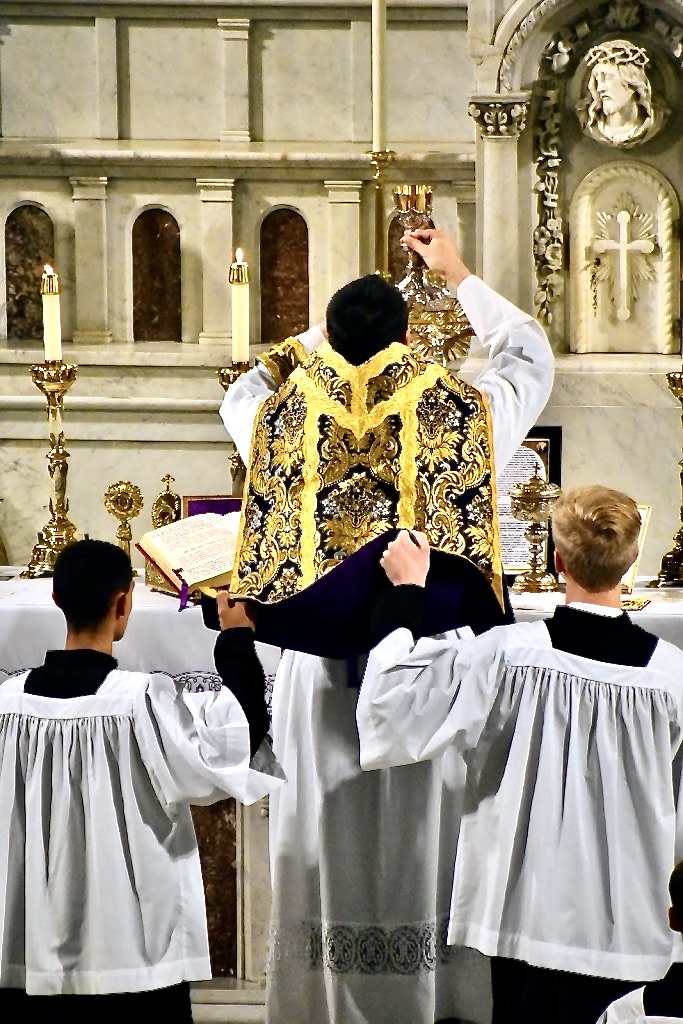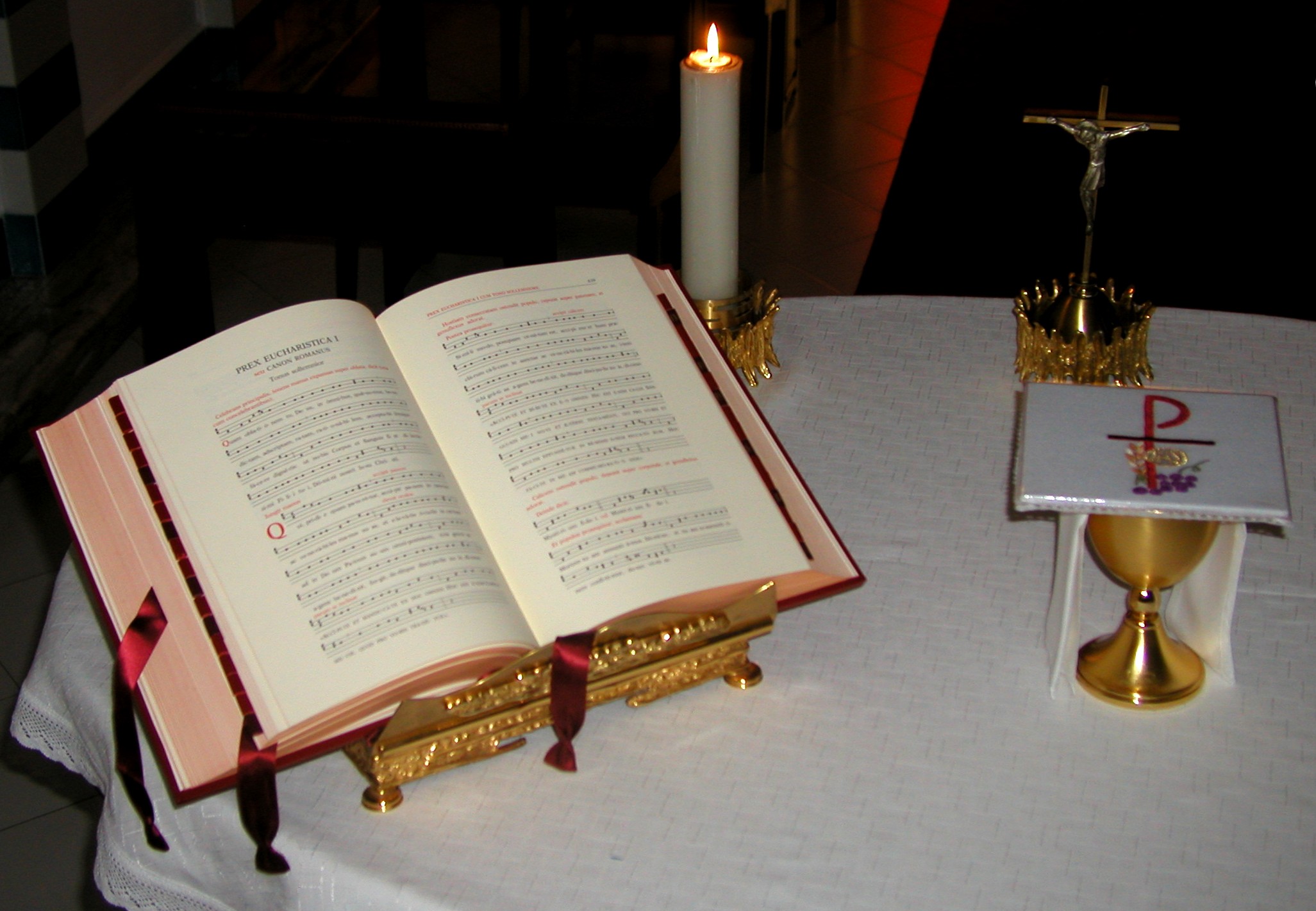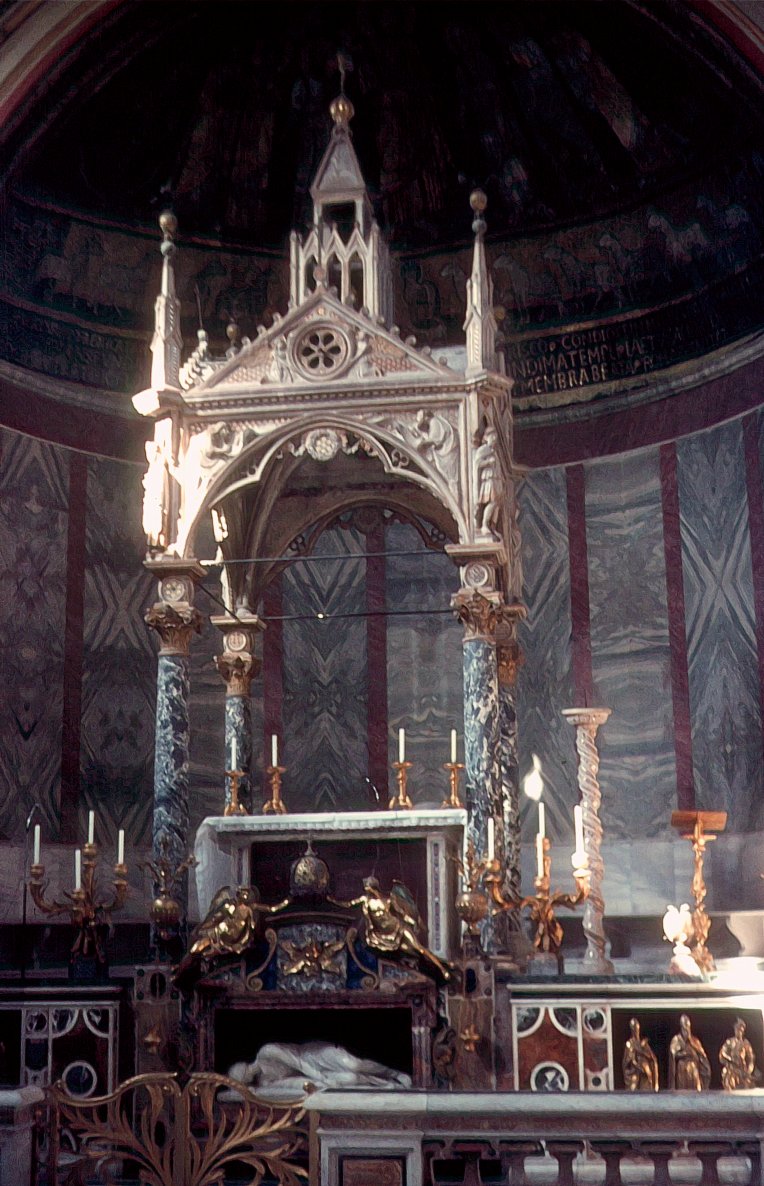|
Missa Cantata
''Missa cantata'' (Latin for "sung Mass") is a form of Tridentine Mass defined officially in 1960 as a sung Mass celebrated without sacred ministers, i.e., deacon and subdeacon. Pre-1960 name Documents of the Holy See such as thDecree of the Congregation of Sacred Rites of 14 March 1906spoke of ''Missa cantata sine Ministris'' (Sung/Chanted Mass without the Ministers). The 19th-century ''Ceremonial for the Use of the Catholic Churches in the United States of America'' (commonly called the "Baltimore Ceremonial" because published by request of the Third Plenary Council of Baltimore of 1884) used the name: High Mass without Deacon or Sub-Deacon Classification The ''Baltimore Ceremonial'' thus classified the ''Missa cantata'' as a High Mass. The early 20th-century ''Catholic Encyclopedia'' said, on the contrary, that a ''Missa cantata'' "is really a low Mass, since the essence of high Mass is not the music but the deacon and subdeacon. Only in churches which have no ordained ... [...More Info...] [...Related Items...] OR: [Wikipedia] [Google] [Baidu] |
Church Cantata
A church cantata or sacred cantata is a cantata intended to be performed during Christian liturgy. The genre was particularly popular in 18th-century Lutheran Germany, with many composers writing an extensive output: Gottfried Heinrich Stölzel, Stölzel, Georg Philipp Telemann, Telemann, Christoph Graupner, Graupner and Johann Krieger, Krieger each wrote nearly or more than a thousand. The best known examples, however, are those of Johann Sebastian Bach, whose output stands out not by quantity but by the high level of expertise and craftmanship which they showcase. The bulk of extant cantatas were composed for occasions occurring in the liturgical calendar of the German Reformation era, including Passion cantatas for Good Friday, and most made reference to the content of the readings and to Lutheran hymns appropriate for the occasion. The chorale, melodies of such hymns often appeared in cantatas, for example as in the four-part harmony, four-part settings concluding Bach's wor ... [...More Info...] [...Related Items...] OR: [Wikipedia] [Google] [Baidu] |
Subdeacon
Subdeacon is a minor orders, minor order of ministry for men or women in various branches of Christianity. The subdeacon has a specific liturgical role and is placed below the deacon and above the acolyte in the order of precedence. Subdeacons in the Eastern Orthodox Church A subdeacon, also called hypodeacon, is the highest of the minor orders of clergy in the Eastern Orthodox Church. This order is higher than the Reader (liturgy), reader and lower than the deacon. Canonical discipline Like the reader, the clerical street-dress of the subdeacon is the cassock, which is usually black but only need be so if he is a monk. This is symbolic of their suppression of their own tastes, will, and desires, and their canonical obedience to God, their bishop, and the liturgical and canonical norms of the Church. As a concession in countries where Eastern Orthodoxy is little known, many only wear the cassock when attending liturgies or when moving about the faithful on church business. In so ... [...More Info...] [...Related Items...] OR: [Wikipedia] [Google] [Baidu] |
Catholic Liturgy
Catholic liturgy means the whole complex of official liturgical worship, including all the rites, ceremonies, prayers, and sacraments of the Church, as opposed to private or collective devotions. In this sense the arrangement of all these services in certain set forms (including the canonical hours, administration of sacraments, etc.) is meant. Liturgy encompasses the entire service: prayer, reading and proclamation, singing, gestures, movement and vestments, liturgical colours, symbols and symbolic actions, the administration of sacraments and sacramentals. Etymology ''Liturgy'' (from ) is a composite word meaning originally a public duty, a service to the state undertaken by a citizen. A ''leitourgos'' was "a man who performs a public duty", "a public servant", ''leitourgeo'' was "to do such a duty", ''leitourgema'' its performance, and ''leitourgia'', the public duty itself. So in the use of liturgy meant the public official service of the Church, that corresponded t ... [...More Info...] [...Related Items...] OR: [Wikipedia] [Google] [Baidu] |
General Instruction Of The Roman Missal
The ''General Instruction of the Roman Missal'' (GIRM)—in the Latin original, (IGMR)—is the detailed document governing the celebration of Mass of the Roman Rite in what since 1969 is its normal form. Originally published in 1969 as a separate document, it is printed at the start of editions of the Roman Missal since 1970. __NOTOC__ Background The 1960 '' Code of Rubrics'' replaced the ''Rubricae Generales Missalis'', which had been in the Tridentine Roman Missal since its first edition in 1570 and had been amplified and revised by Pope Clement VIII in 1604. This had been supplemented, since the 1920 edition, by the ''Additiones et Variationes in Rubricis Missalis ad normam Bullae "Divino afflatu" et subsequentium S.R.C. decretorum'' (Additions and Variations to the Rubrics of the Missal in accordance with the Bull ''Divino afflatu'' and subsequent decrees of the Sacred Congregation of Rites), which indicated the changes in the Roman Missal that followed from the reform o ... [...More Info...] [...Related Items...] OR: [Wikipedia] [Google] [Baidu] |
Roman Missal
The Roman Missal () is the book which contains the texts and rubrics for the celebration of the Roman Rite, the most common liturgy and Mass of the Catholic Church. There have been several editions. History Before the Council of Trent (1570) Before the high Middle Ages, several books were used at Mass: a Sacramentary with the prayers, one or more books for the Scriptural readings, and one or more books for the antiphons and other chants. Gradually, manuscripts came into being that incorporated parts of more than one of these books, leading finally to versions that were complete in themselves. Such a book was referred to as a ''Missale Plenum'' (). In 1223 Saint Francis of Assisi instructed his friars to adopt the form that was in use at the Papal Court (''Rule'', chapter 3). They adapted this missal further to the needs of their largely itinerant apostolate. Pope Gregory IX considered, but did not put into effect, the idea of extending this missal, as revised by the Francis ... [...More Info...] [...Related Items...] OR: [Wikipedia] [Google] [Baidu] |
Roman Rite
The Roman Rite () is the most common ritual family for performing the ecclesiastical services of the Latin Church, the largest of the ''sui iuris'' particular churches that comprise the Catholic Church. The Roman Rite governs Rite (Christianity), rites such as the Roman Mass and the Liturgy of the Hours as well as the manner in which Sacraments of the Catholic Church, sacraments and Blessing in the Catholic Church, blessings are performed. The Roman Rite developed in the Latin language in the city of Rome and, while distinct Latin liturgical rites such as the Ambrosian Rite remain, the Roman Rite has gradually been adopted almost everywhere in the Latin Church. In medieval times there were numerous local variants, even if all of them did not amount to distinct rites, yet uniformity increased as a result of the invention of printing and in obedience to the decrees of the Council of Trent of 1545–1563 (see ''Quo primum''). Several Latin liturgical rites which had survived into th ... [...More Info...] [...Related Items...] OR: [Wikipedia] [Google] [Baidu] |
Gregorian Chant
Gregorian chant is the central tradition of Western plainsong, plainchant, a form of monophony, monophonic, unaccompanied sacred song in Latin (and occasionally Greek language, Greek) of the Roman Catholic Church. Gregorian chant developed mainly in western and central Europe during the 9th and 10th centuries, with later additions and redactions. Although popular legend credits Pope Gregory I with inventing Gregorian chant, scholars believe that he only ordered a compilation of melodies throughout the whole Christian world, after having instructed his emissaries in the Schola cantorum, where the Neume, neumatical notation was perfected, with the result of most of those melodies being a later Carolingian synthesis of the Old Roman chant and Gallican chant. Gregorian chants were organized initially into four, then eight, and finally 12 mode (music), modes. Typical melodic features include a characteristic Ambitus (music), ambitus, and also characteristic intervallic patterns relat ... [...More Info...] [...Related Items...] OR: [Wikipedia] [Google] [Baidu] |
Solemn Mass
Solemn Mass () is the full ceremonial form of a Mass, predominantly associated with the Tridentine Mass where it is celebrated by a priest with a deacon and a subdeacon, requiring most of the parts of the Mass to be sung, and the use of incense. It is also called High Mass or Solemn High Mass. These terms distinguish it from a Low Mass and Missa cantata. The parts assigned to the deacon and subdeacon are often performed by priests in vestments proper to those roles. A Solemn Mass celebrated by a bishop has its own particular ceremonies and is referred to as a Solemn Pontifical Mass. Within the Roman Rite, the history of the Solemn Mass has been traced to the 7th century in the Gregorian Sacramentary and '' Ordo Romanus Primus'', followed by several centuries of adapting these pontifical liturgies. Eventually, the proliferation of multiple parish churches within the same cities saw these liturgies further adapted so that the average priest could celebrate them. By the 13th cen ... [...More Info...] [...Related Items...] OR: [Wikipedia] [Google] [Baidu] |
Mass (liturgy)
Mass is the main Eucharistic liturgical service in many forms of Western Christianity. The term ''Mass'' is commonly used in the Catholic Church, Western Rite Orthodoxy, Old Catholicism, and Independent Catholicism. The term is also used in many Lutheran churches, as well as in some Anglican churches, and on rare occasion by other Protestant churches. Other Christian denominations may employ terms such as '' Divine Service'' or '' worship service'' (and often just "service"), rather than the word ''Mass''. For the celebration of the Eucharist in Eastern Christianity, including Eastern Catholic Churches, other terms such as ''Divine Liturgy'', ''Holy Qurbana'', ''Holy Qurobo'' and ''Badarak'' (or ''Patarag'') are typically used instead. Etymology The English noun ''Mass'' is derived from the Middle Latin . The Latin word was adopted in Old English as (via a Vulgar Latin form ), and was sometimes glossed as ''sendnes'' (i.e. 'a sending, dismission'). The Latin term itself w ... [...More Info...] [...Related Items...] OR: [Wikipedia] [Google] [Baidu] |
Deacon
A deacon is a member of the diaconate, an office in Christian churches that is generally associated with service of some kind, but which varies among theological and denominational traditions. Major Christian denominations, such as the Catholic Church, the Oriental Orthodox Churches, the Eastern Orthodox Church, Lutheranism, Presbyterianism, Methodism, and Anglicanism, view the diaconate as an order of ministry. Permanent deacons (or distinctive deacons) are those who do not later transition to another form of ministry, in contrast to those continuing their formation who are then often called transitional deacons. Origin and development The word ''deacon'' is derived from the Greek word (), which is a standard ancient Greek word meaning "servant", "waiter", "minister", or "messenger". Recent research has highlighted the role of the deacon "as a co-operator" and "go-between," emphasizing their intermediary position in early Christian communities. It is generally assum ... [...More Info...] [...Related Items...] OR: [Wikipedia] [Google] [Baidu] |
Elevation Of Chalice 1
The elevation of a geographic ''location'' is its height above or below a fixed reference point, most commonly a reference geoid, a mathematical model of the Earth's sea level as an equipotential gravitational surface (see Geodetic datum § Vertical datum). The term ''elevation'' is mainly used when referring to points on the Earth's surface, while ''altitude'' or ''geopotential height'' is used for points above the surface, such as an aircraft in flight or a spacecraft in orbit, and '' depth'' is used for points below the surface. Elevation is not to be confused with the distance from the center of the Earth. Due to the equatorial bulge, the summits of Mount Everest and Chimborazo have, respectively, the largest elevation and the largest geocentric distance. Aviation In aviation, the term ''elevation'' or ''aerodrome elevation'' is defined by the ICAO as the highest point of the landing area. It is often measured in feet and can be found in approach charts of the aerodrome ... [...More Info...] [...Related Items...] OR: [Wikipedia] [Google] [Baidu] |
Code Of Rubrics
The Code of Rubrics is a three-part liturgical document promulgated in 1960 under Pope John XXIII, which in the form of a legal code indicated the liturgical and sacramental law governing the celebration of the Roman Rite Mass and Divine Office. Pope John approved the Code of Rubrics by the ''motu proprio'' ''Rubricarum instructum'' of 25 July 1960. The Sacred Congregation of Rites promulgated the Code of Rubrics, a revised calendar, and changes (''variationes'') in the Roman Breviary and Missal and in the Roman Martyrology by the decree ''Novum rubricarum'' the next day. In the Roman Breviary, the Code of Rubrics replaced the previous rules. In the Roman Missal, it replaced the sections, ''Rubricae generales Missalis'' (General Rubrics of the Missal) and ''Additiones et variationes in rubricis Missalis ad normam Bullae "Divino afflatu" et subsequentium S.R.C. Decretorum'' (Additions and alterations to the Rubrics of the Missal in line with the Bull ''Divino afflatu'' and the ... [...More Info...] [...Related Items...] OR: [Wikipedia] [Google] [Baidu] |







